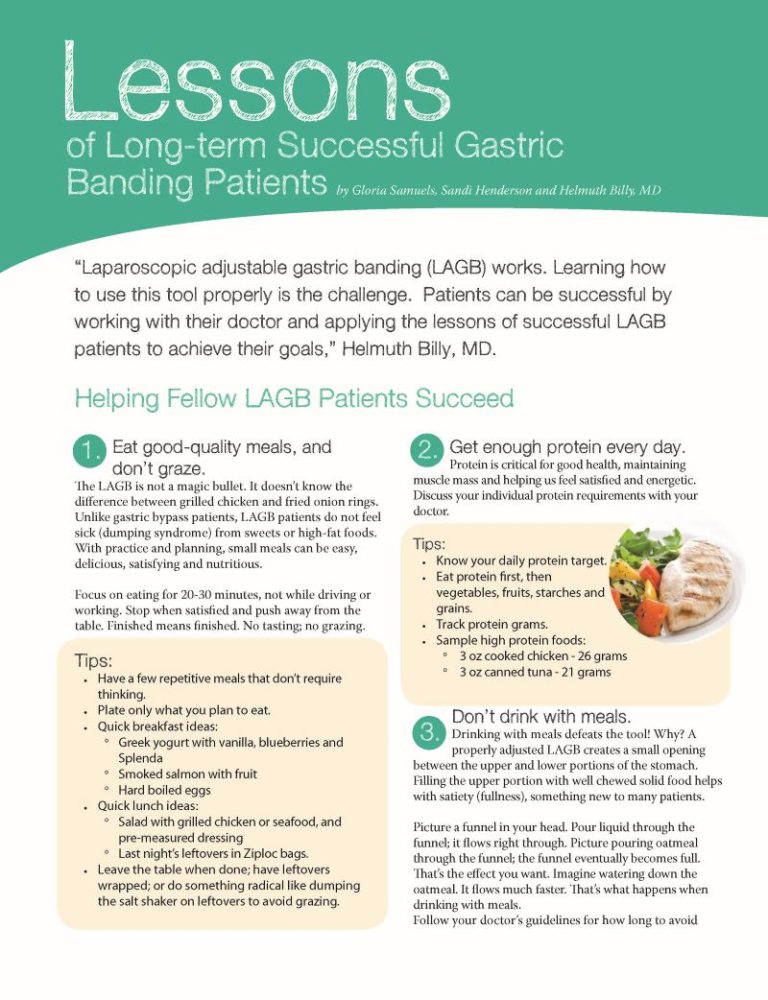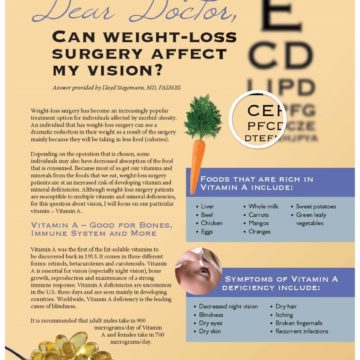Lessons of Long-term Successful Gastric Banding Patients


by Gloria Samuels, Sandi Henderson and Helmuth Billy, MD
Summer 2011
“Laparoscopic adjustable gastric banding (LAGB) works. Learning how to use this tool properly is the challenge. Patients can be successful by working with their doctor and applying the lessons of successful LAGB patients to achieve their goals,” Helmuth Billy, MD.
Helping Fellow LAGB Patients Succeed
1. Eat good-quality meals, and don’t graze.
The LAGB is not a magic bullet. It doesn’t know the difference between grilled chicken and fried onion rings. Unlike gastric bypass patients, LAGB patients do not feel sick (dumping syndrome) from sweets or high-fat foods. With practice and planning, small meals can be easy, delicious, satisfying and nutritious.
Focus on eating for 20-30 minutes, not while driving or working. Stop when satisfied and push away from the table. Finished means finished. No tasting; no grazing.
Tips:
- Have a few repetitive meals that don’t require thinking.
- Plate only what you plan to eat.
Quick breakfast ideas:
– Greek yogurt with vanilla, blueberries and Splenda
– Smoked salmon with fruit
– Hard boiled eggs
Quick lunch ideas:
– Salad with grilled chicken or seafood, and pre-measured dressing
– Last night’s leftovers in Ziploc bags.
- Leave the table when done; have leftovers wrapped; or do something radical like dumping the salt shaker on leftovers to avoid grazing.
2. Get enough protein every day.
Protein is critical for good health, maintaining muscle mass and helping us feel satisfied and energetic. Discuss your individual protein requirements with your doctor.
Tips:
- Know your daily protein target.
- Eat protein first, then vegetables, fruits, starches and grains.
- Track protein grams.
- Sample high protein foods:
– 3 oz cooked chicken – 26 grams
– 3 oz canned tuna – 21 grams
3. Don’t drink with meals.
Drinking with meals defeats the tool! Why? A properly adjusted LAGB creates a small opening between the upper and lower portions of the stomach. Filling the upper portion with well chewed solid food helps with satiety (fullness), something new to many patients.
Picture a funnel in your head. Pour liquid through the funnel; it flows right through. Picture pouring oatmeal through the funnel; the funnel eventually becomes full. That’s the effect you want. Imagine watering down the oatmeal. It flows much faster. That’s what happens when drinking with meals.
Follow your doctor’s guidelines for how long to avoid drinking before and after meals.
Tips:
- Remove your glass from the table.
- Set timers for when to stop and start drinking.
4. Eat, don’t drink, calories.
A properly adjusted band only restricts solid foods. Drinking calories prevents the band from doing its job and leads to failure.
Tips:
- Drink at least 64 oz of water daily; carry water everywhere.
- Check calories of your favorite drinks. Surprised?
- Artificially sweetened drinks may actually leave you hungrier. Beware!
5. Take small bites; chew thoroughly.
The LAGB reminds you to slow down, take small bites and chew. Taking a big bite and wolfing it down can feel like an elephant sitting on your chest. Slowing down allows you to recognize when you’ve had enough. Small portions should be satisfying.
Tips:
- Use salad plates, not dinner plates; 4 ounce bowls, not 12 ounce bowls; teaspoons, not tablespoons.
- Put your fork down between every bite; chew at least 20 times.
- Save an empty Lean Cuisine “plate” to approximate correct portion size.
6. Learn what foods are difficult and avoid them.
These foods commonly cause difficulties:
- Bread
- Rice
- Pasta
- Steaks and chops
- Raw, fibrous fruits and vegetables
Learn what foods are difficult by listening to your body. This is different for everyone. Avoiding difficult foods and building tasty band-friendly meals can keep you and your family happy and satisfied.
Tips:
- Introduce commonly difficult foods, one at a time.
- Enjoy cooking? Challenge yourself to find tasty foods that meet your dietary guidelines.
7. Always have a plan.
Planning ahead eliminates excuses. Never get caught hungry without a plan.
Tips:
- Planning a day, week or meal ahead insures you are never caught without the right foods to work with your tool.
- A rough plan is better than no plan.
- Most restaurants have nutritional information available online; look before you go! Have a backup plan when you can’t control what is served. Keep a stash of jerky, protein powder or other portable food in your office, car or backpack.
8. Learn to journal.
Journaling helps you be accountable and get back to basics by tracking everything you eat and drink. Each day, track calories, protein and fluid. Use your journal to work with healthcare professionals and nutritionists to spot trends, identify triggers and refine choices. Studies show journaling leads to better weight-loss.
Tips:
- Journal – Just do it!
- Try an “app” or online tool; it’s never been easier.
9. Stay close to your surgical practice and surround yourself with successful patients.
LAGB patients require significant aftercare especially during the first 12 months. Getting great results requires working closely with the surgical practice. It’s imperative not to compare band patients with bypass patients during the first 6-12 months. Band patients lose weight at a slower pace; the weight-loss phase really begins with a properly adjusted gastric band. Working closely with the surgical practice and knowing what to expect are critical.
Tips:
- Make appointments ahead of time and keep them.
- Take advantage of ALL your practice has to offer.
- Find a LAGB-only support group.
- Use online support resources.
10. Make yourself a priority.
Those who struggle with serious weight issues often have trouble prioritizing themselves. You cannot get the most from this tool without making yourself a priority!
Tips:
- Have a plan to work with your tool daily.
- Fit exercise into your busy schedule.
- Take vitamins just like you brush your teeth.
- Live life; get out and participate instead of watching life go by.
About the Authors:
Helmuth Billy, MD, is currently the director of Bariatric Surgery at St. John’s Regional Medical Center located in Oxnard, Calif., a recognized bariatric Center of Excellence. Dr. Billy obtained his undergraduate degree in Molecular Biology at the University of California, Berkeley. He subsequently received his medical degree at the University of California, Davis, School of Medicine.
Gloria Samuels and Sandi Henderson are the founders of bandedliving.com, the community for gastric banding patients, by patients, and the authors of the book, Is Lap Band Surgery for Me? Gloria Samuels is a highly successful LAGB patient and mentor to bariatric surgery patients. Sandi Henderson is extraordinary in the world of LAGB, having lost 250 pounds since her surgery in May 2004. She has maintained her weight-loss since 2006. Gloria Samuels and Sandi Henderson are both members of the OAC Advisory Board.
by Sarah Muntel, RD Spring 2024 Spring has sprung, bringing sunnier and warmer days! For many, this…
Read Articleby Kendall Griffey, OAC Communications Manager Spring 2024 We have officially kicked off Your Weight Matters Regional…
Read Articleby Robyn Pashby, PhD Winter 2024 “No one is ever going to date you if you don’t…
Read Article









